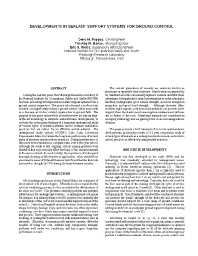Mining Publication: Developments in Sealant Support Systems for Ground Control
Original creation date: August 2002
During the past few years, the Pittsburgh Research Laboratory of the National Institute for Occupational Safety and Health (NIOSH) has been evaluating developments in sealant support systems from a ground control perspective. The proper selection and use of a sealant material can significantly enhance ground control which may result in a decrease in worker related injuries due to ground falls. The purpose of this paper is threefold: to briefly review the current state of-the-art technology in shotcrete and membrane developments, to evaluate the preliminary findings of a long-term underground study of various types of sealant materials, and to examine installation practices that are critical for an effective sealant material. The underground study utilizes NIOSH's Lake Lynn Laboratory Experimental Mine to evaluate the long-term performance of several types of shotcrete and membrane materials. Sealant performance to date have been evaluated on a regular basis over a two year period. Although the study is still ongoing, critical mining practices were identified that may seriously effect the bond of the sealant materials to the mine roof and rib; most notably, the importance of scaling and thorough cleaning of the rib prior to application. Also, results from an extensive series of Schmidt Hammer tests found that the shotcrete increased in strength by 70% during the humid summer months.
Authors: DM Pappas, TM Barton, ES Weiss
Conference Paper - August 2002
NIOSHTIC2 Number: 20023141
In: Peng SS, Mark C, Khair AW, Heasley KA, eds. Proceedings of the 21st International Conference on Ground Control in Mining. Morgantown, WV: West Virginia University, 2002 Aug; :344-353
See Also
- Calibration and Verification of Longwall Stress Models
- Coal Mine Safety Applications of Seismic Monitoring
- Durable Support for Western U.S. Underground Metal Mines
- Early Strength Performance of Modern Weak Rock Mass Shotcrete Mixes
- Ground Control Safety for Deep Vein Mines
- Ground Monitoring
- The Long-term Performance of Surface Support Liners for Ground Control in an Underground Limestone Mine
- Roof Support
- Shotcrete Design and Installation Compliance Testing: Early Strength, Load Capacity,Toughness, Adhesion Strength, and Applied Quality
- Technology News 542 - Field Use Round Determinate Panel Test System
- Page last reviewed: 9/21/2012
- Page last updated: 9/21/2012
- Content source: National Institute for Occupational Safety and Health, Mining Program


 ShareCompartir
ShareCompartir
